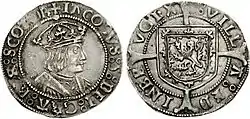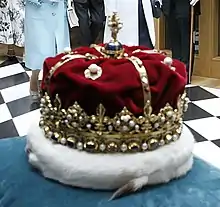
Adam Leys or Leis was a Scottish goldsmith based in Edinburgh.[1] He worked for James V of Scotland and, in the 1530s, repaired and refashioned the Scottish crown jewels known as the Honours of Scotland.
Works

Adam Leys made a silver chalice for James V's almoner in August 1535.[2] James V employed Adam Leys to repair and augment the crown of Scotland in 1532 and 1536.[3] The treasurer's accounts mention that he added new "spryngis" in 1532. It is perhaps unclear which elements these were, but the record may refer to new Imperial-style arches.[4] The crown was comprehensively reworked again by John Mosman in January 1540, into the form it has today.[5]
Leys also worked on the Sword of Honour, a gift from Pope Julius II,[6] and the silver sceptre, a gift to James IV from Pope Alexander VI in 1494, which he extended and gilded.[7] These works were probably in connection with ceremonies planned for James V's bride, Madeleine of Valois.[8] The royal accounts recorded these works in the Scots language as:
- Item, deliverit to the said James [Achesoun] to Adam Leis, goldsmyth, to mend the sword of honour, thre unce of Inglis grotis
- Item deliverit to Adam Leys, goldsmyth, xj unce and ane half of silver, attour the auld sceptour of silver weyand xv unce, to mak ane new sceptour of [silver]
- Item, for gold to gilt the samin [same].[9]
Leys made an engraved silver seal for David Beaton in 1539.[10]
References
- ↑ Jean Munro & Henry Steuart Fotheringham, Edinburgh Goldsmith's Minutes (Edinburgh: STS, 2006), p. 13.
- ↑ James Balfour Paul, Accounts of the Treasurer of Scotland, vol. 6 (Edinburgh, 1905), p. 248.
- ↑ Papers Relative to the Regalia of Scotland (Edinburgh, 1829), p. 30: Accounts of the Treasurer of Scotland, vol. 6 (Edinburgh, 1905), p. 73.
- ↑ Andrea Thomas, 'Coronation Ritual and Regalia', Julian Goodare & Alasdair A. MacDonald, Sixteenth-Century Scotland (Brill, 2008), pp. 59–60.
- ↑ Andrea Thomas, Glory and Honour (Edinburgh, 2013), p. 187.
- ↑ Jamie Reid-Baxter, 'James IV and Robert Carver', Kate Buchanan, Lucinda Dean, Michael Penman, Medieval and Early Modern Representations of Authority in Scotland and the British Isles (Routledge, 2016), pp. 238–241.
- ↑ Chris Tabraham, The Honours of Scotland: The Story of the Scottish Crown Jewels and the Stone of Destiny (Edinburgh: Historic Environment Scotland, 2019), p. 40: Papers Relative to the Regalia of Scotland (Edinburgh, 1829), p. 30.
- ↑ Andrea Thomas, 'Coronation Ritual and Regalia', Julian Goodare & Alasdair A. MacDonald, Sixteenth-Century Scotland (Brill, 2008), p. 57.
- ↑ James Balfour Paul, Accounts of the Treasurer of Scotland, vol. 6 (Edinburgh, 1905), pp. 285–286.
- ↑ David H. Caldwell, 'Lead seal matrices of the 16th and early 17th century', PSAS, 123 (1994), p. 379: Robert Kerr Hannay, Rentale Sancti Andree (Edinburgh: SHS, 1913), p. 93